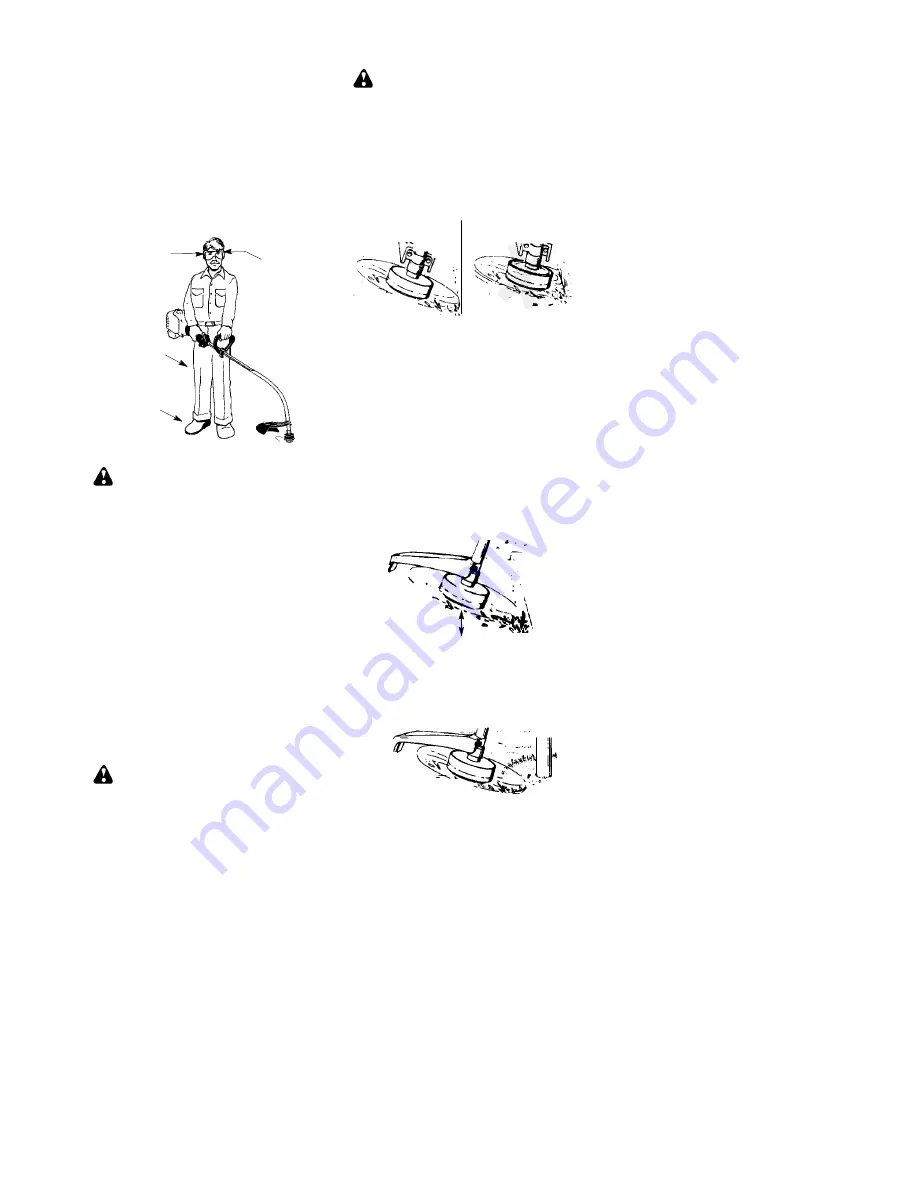
6
NOTE:
If engine has not started, pull starter
rope 5 more pulls. If engine still does not run, it
is probably flooded.
STARTING A FLOODED ENGINE
Flooded engines can be started by placing
the choke lever in the RUN position; then, pull
the rope to clear the engine of excess fuel.
This could require pulling the starter handle
many times depending on how badly the unit
is flooded. If the unit still doesn’t start, refer to
TROUBLESHOOTING TABLE.
OPERATING INSTRUCTIONS
OPERATING POSITION
Cut from your right to your left.
ALWAYS WEAR:
Eye protection
Long pants
Heavy shoes
Hearing
protection
WARNING:
Always wear eye protec-
tion and hearing protection. Never lean over
the trimmer head. Rocks or debris can rico-
chet or be thrown into eyes and face and
cause blindness or other serious injury.
Do not run the engine at a higher speed than
necessary. The cutting line will cut efficiently
when the engine is run at less than full throttle.
At lower speeds, there is less engine noise and
vibration. The cutting line will last longer and will
be less likely to “weld” onto the spool.
Always release the throttle trigger and allow the
engine to return to idle speed when not cutting.
To stop engine:
S
Release the throttle trigger.
S
Move the ON/OFF switch to the OFF posi-
tion.
TRIMMER LINE ADVANCE
Advance line by tapping the bottom of the cut-
ting head lightly on the ground while engine is
running at full speed. The metal line limiter
blade attached to the guard will cut the line to
the proper length.
WARNING:
Use only 2 mm diameter
line. Other sizes and shapes of line will not ad-
vance properly and will result in improper cut-
ting head function or can cause serious injury.
Do not use other materials such as wire,
string, rope, etc. Wire can break off during
cutting and become a dangerous missile that
can cause serious injury.
CUTTING METHODS
WARNING:
Use minimum speed and
do not crowd the line when cutting around
hard objects (rock, gravel, fence posts, etc.),
which can damage the trimmer head, become
entangled in the line, or be thrown causing a
serious hazard.
S
The tip of the line does the cutting. You will
achieve the best performance and mini-
mum line wear by not crowding the line into
the cutting area. The right and wrong ways
are shown below.
Tip of the Line
Does The Cutting
Right
Wrong
Line Crowded Into
Work Area
S
The line will easily remove grass and
weeds from around walls, fences, trees and
flower beds, but it also can cut the tender
bark of trees or shrubs and scar fences.
S
For trimming or scalping, use less than full
throttle to increase line life and decrease
head wear, especially:
S
During light duty cutting.
S
Near objects around which the line can-
wrap such as small posts, trees or fence
wire.
S
For mowing or sweeping, use full throttle for
a good clean job.
TRIMMING -- Hold the bottom of the trimmer
head about 80 mm above the ground and at an
angle. Allow only the tip of the line to make con-
tact. Do not force trimmer line into work area.
Trimming
3 in. (8 cm)
Above Ground
SCALPING -- The scalping technique removes
unwanted vegetation. Hold the bottom of the
trimmer head about 80 mm above the ground
and at an angle. Allow the tip of the line to strike
the ground around trees, posts, monuments,
etc. This technique increases line wear.
Scalping
MOWING -- Your trimmer is ideal for mowing
in places conventional lawn mowers cannot
reach. In the mowing position, keep the line
parallel to the ground. Avoid pressing the
head into the ground as this can scalp the
ground and damage the tool.




























